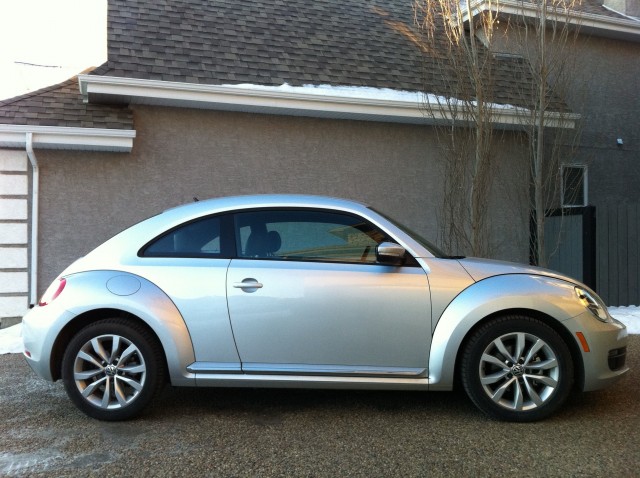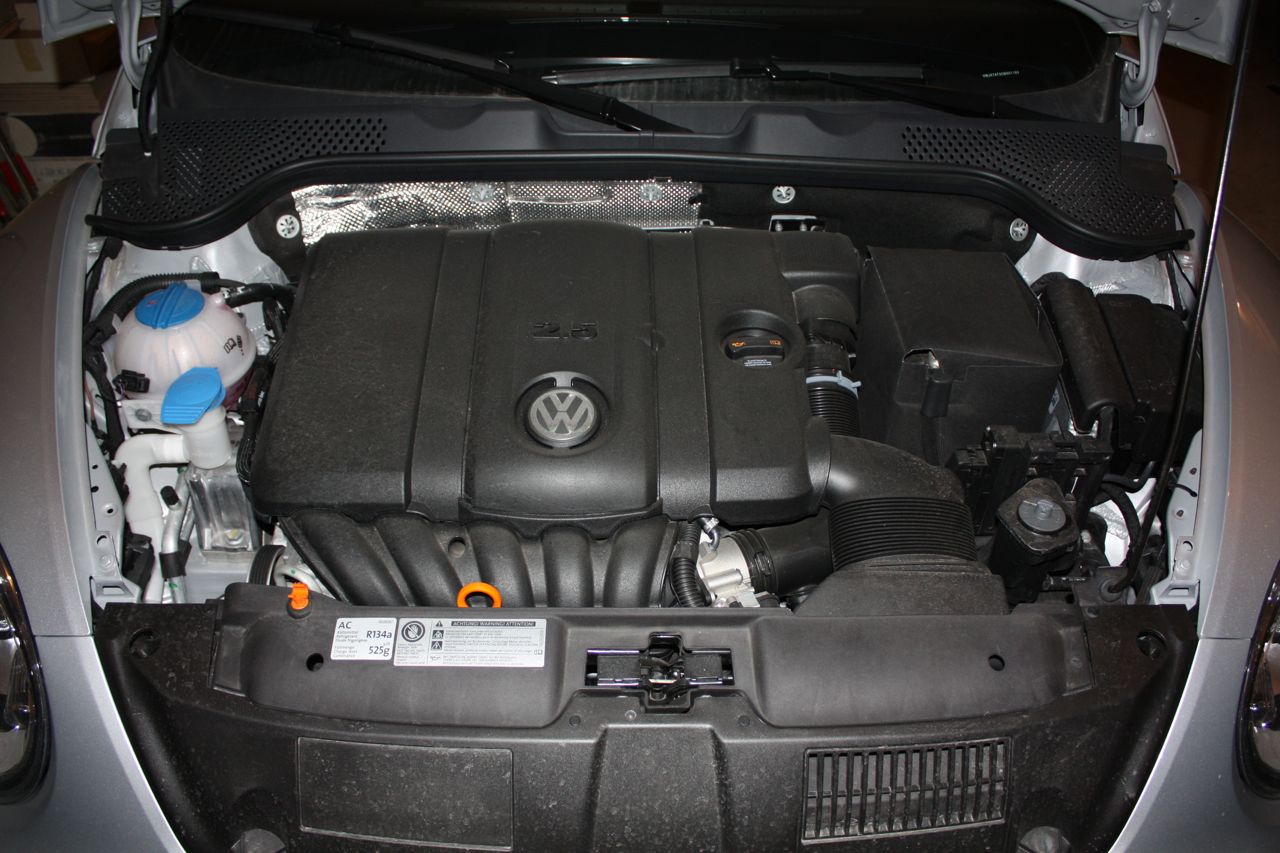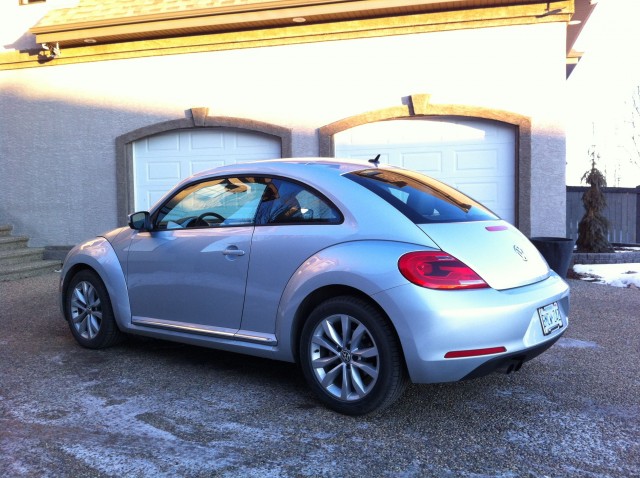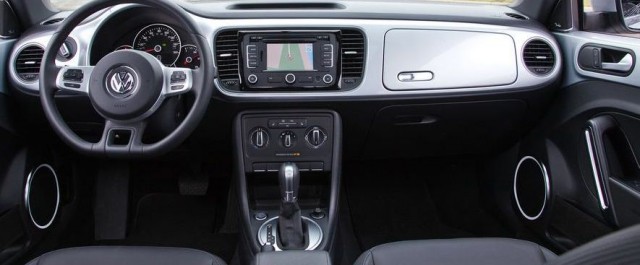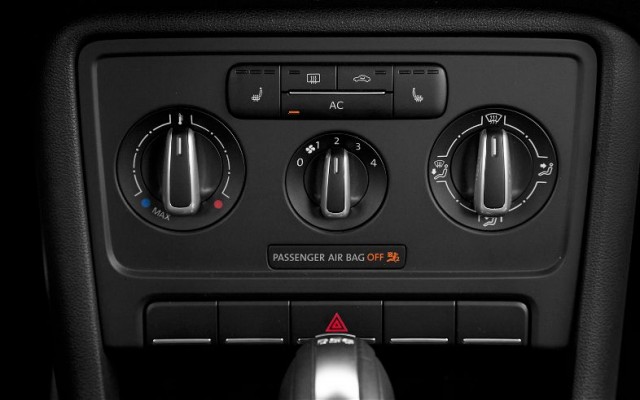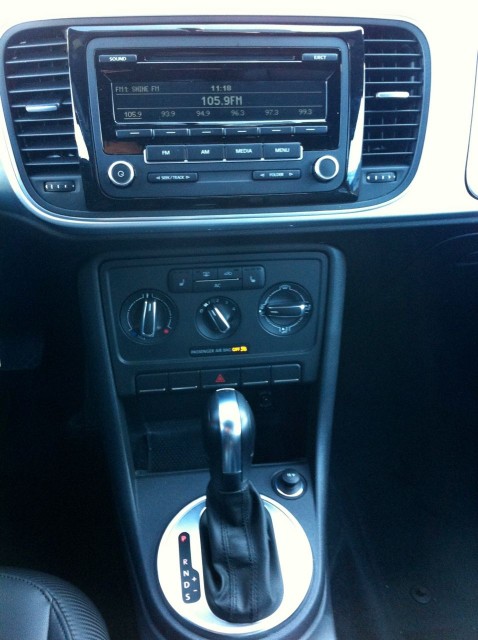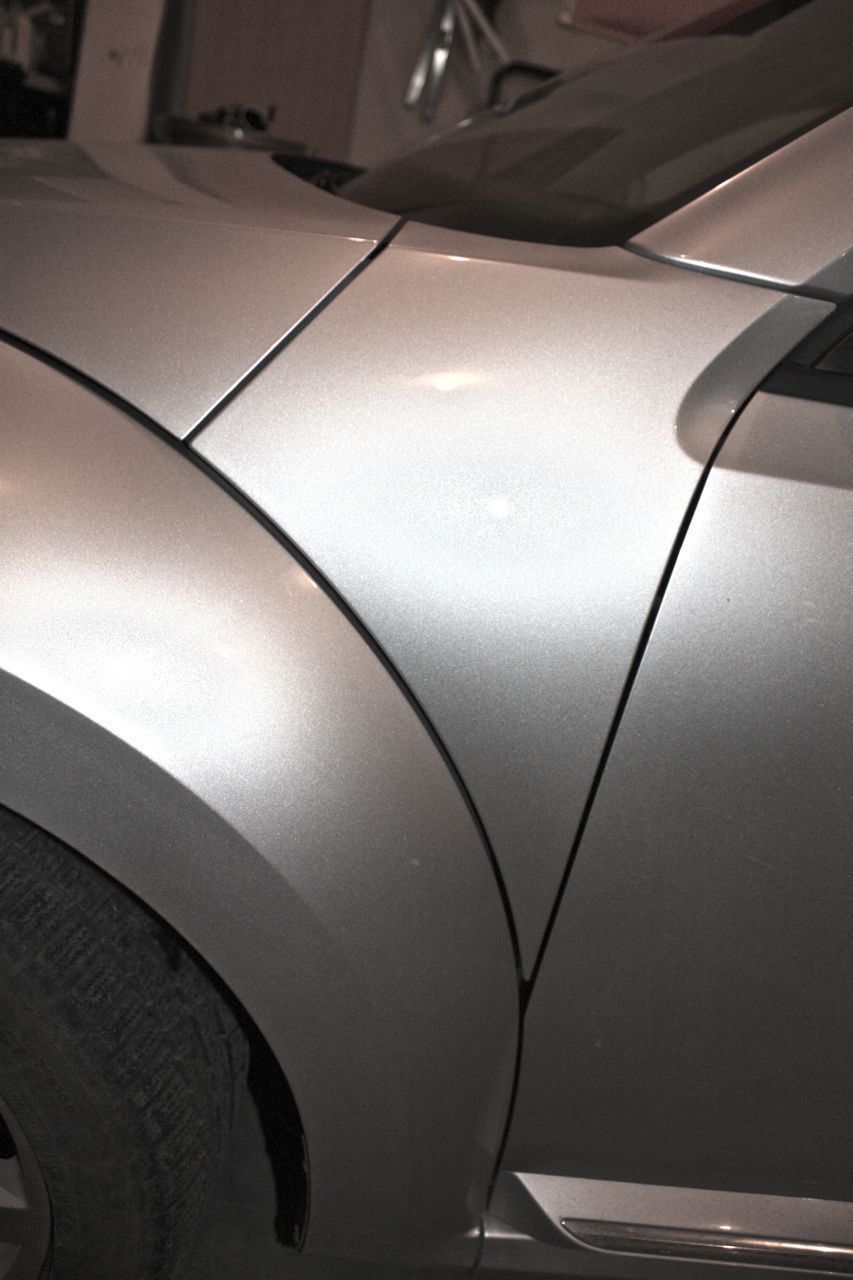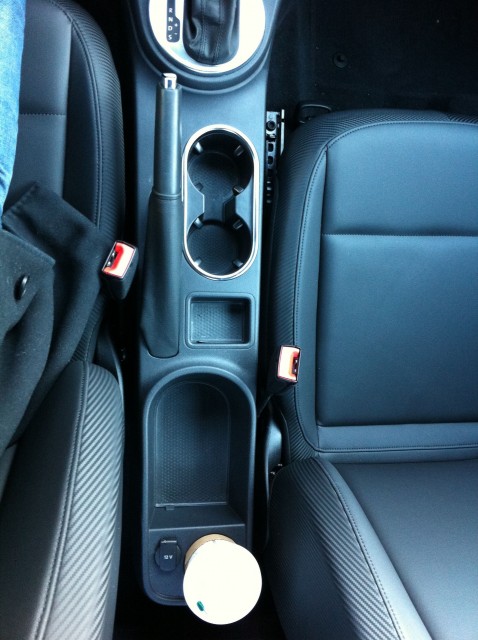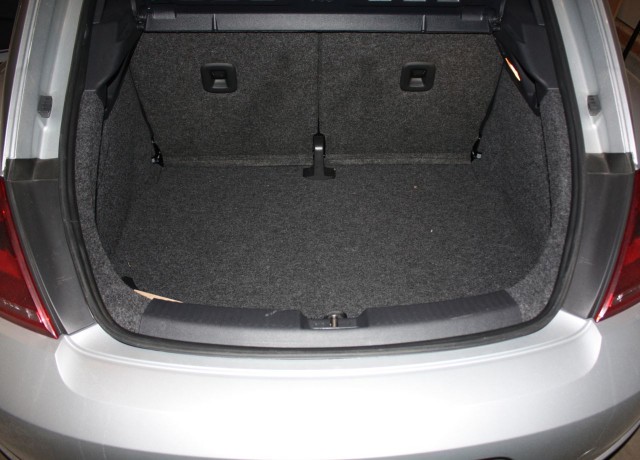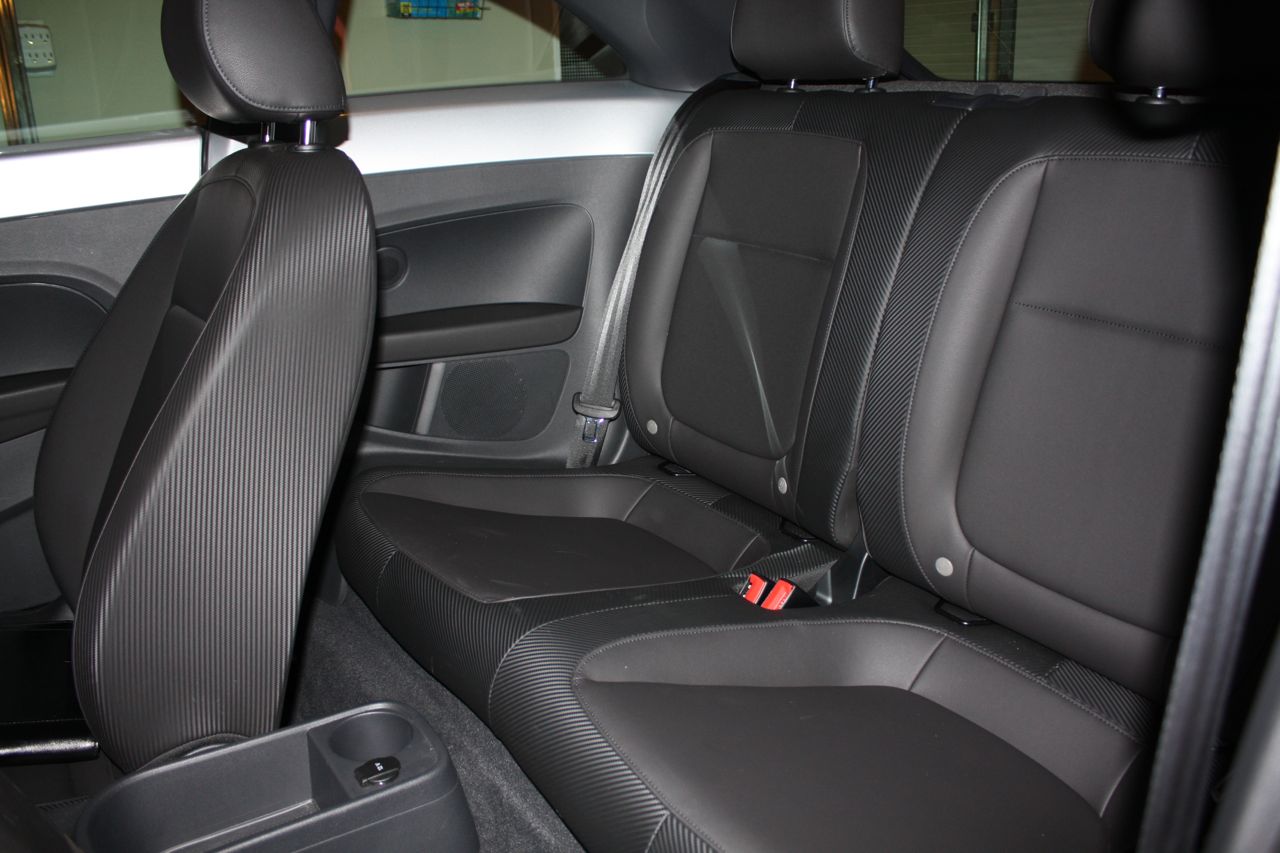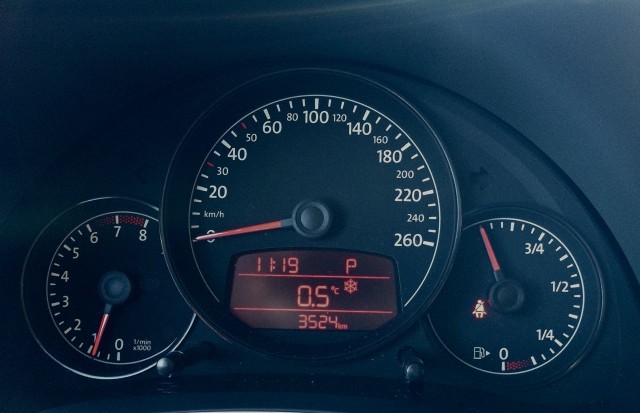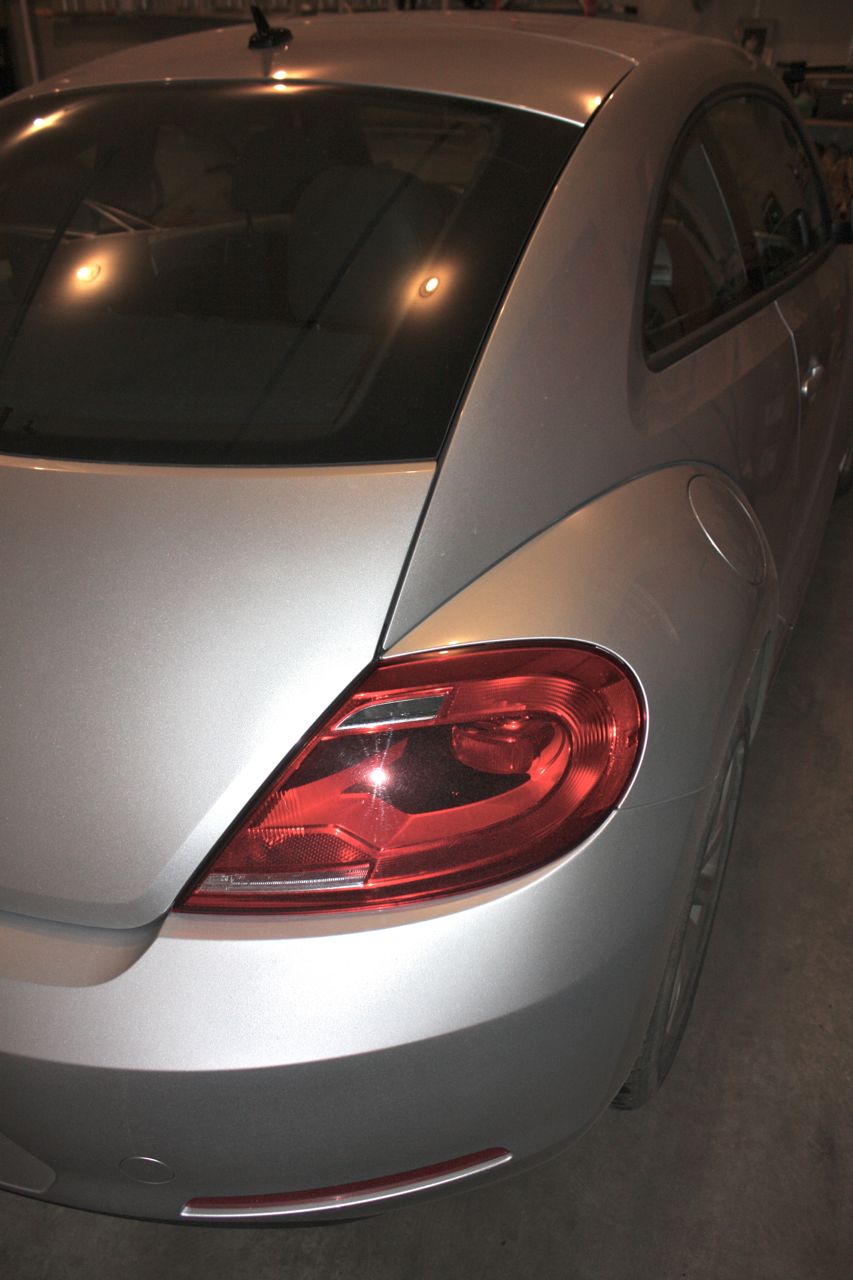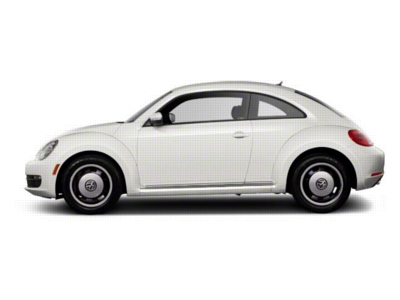Well, one thing’s for sure – nobody will mistake the Beetle for anything else.
That’s a good thing. This car has an impressive history, going back many decades, and although the only relation between that car and this one is the basic shape and the manufacturer’s name, I’ve always thought this was a cool nod to where it came from.
The Beetle was resurrected in 1998 as the New Beetle, and this is now the next generation of the new Beetle, but thankfully VW took the “New” part out of the name. I think Beetle suffices.
Of course, the new Beetles don’t have a clattering air-cooled engine in the back – they share a lot of the basics with a VW Golf underneath the skin.
This was a 2012 Beetle Premiere trim level. The base price of the Premiere is CDN $24,475 and that’s what my test vehicle rang in at as well.
There are a number of possibilities under the hood when it comes to buying a Beetle, and this one came with the base engine. It’s the 2.5 Litre 5-cylinder engine, and it truly wears its experience on its sleeve. This engine, in one shape or form, has been around for a couple of decades, having served time in Audi engine bays as well.
It’s not a bad engine, but because it’s essentially an antique, there are definitely better and more efficient choices out there. It makes 170 HP @ 5700 RPM and 177 lb.ft of torque @ 4250 RPM. Numbers that don’t send the competition running into the shadows, by any stretch of the imagination, but before you consider this a wimp, remember that the engine is only moving 2982 pounds of car around. That’s not as light as the original Beetle, of course, but it’s light by today’s standards, and this configuration pulls off an 8.8 second run to 100 km/h. Not bad.
The 2.5 Litre is mated to a 6-speed Tiptronic automatic, with Sport mode and manual shifting mode.
Since this isn’t the most modern of engines, you’re not going to see stellar numbers in the fuel economy department. It’s rated at 9.5 L/100 km (24.8 mpg) in the city, and 71. L/100 km (33 mpg) on the highway. I didn’t do quite that well. I averaged 11 L/100 km (22 mpg) – which is actually quite good, because I never once tried to drive it economically and mostly had a slightly heavy foot on it, and it was almost exclusively city commuting, with a couple of short sprints down the freeway.
So yes, the base 5-cylinder has a couple of faults (mostly due to its age, and because engine technology has passed it by), but it’s not a horrible engine at all, and its character suits the Beetle quite nicely and makes for a very drivable combination.
Exterior
Here’s the real story. Yes there is some style going on inside, but you can’t even consider a Beetle if you’re not into the shape. The exterior shape is clearly a nod to where the Beetle came from. This generation has made significant changes and in my opinion, each one is a marked improvement.
VW did away with the body shape that seemed to be built out of circles, and allowed the Beetle’s lines to mature. There are slightly more chiseled shapes, longer flowing lines and dare I say it – a hint of masculinity and muscle.
I was very interested in people’s reactions to this car. I thought many would chuckle at it and maybe laugh it off as a styling exercise but here’s the truth – reaction to this car was huge, and 100% positive during the time I had it. A lot of people took the time to come over and comment on it and out of those who did, many knew this was the new generation and indicated they loved it. There was also a consensus that this shape is a major improvement over the last generation.
I loved the changes VW made to the front, back and even the fenders and sides. The biggest change for me was the new roofline, and how it appears to make the car flatter, lower and longer. It’s a good thing, while clearly not forgetting that it’s a Beetle.
I quite liked the new treatment of the rear lights and the headlights as well. You’ll find a shark fin antenna on top and nice signal light repeaters in the side-view mirrors.
This car had the “Rotor” style wheels – I quite liked them.
Interior
The Beetle’s interior has also been made less polarizing in this generation. Certain styling cues in the previous one were love-it-or-hate-it, and VW has again done a great job refining this have a broader appeal. And yes, let me make it clear right off the bat – the flower vase in the dash is gone. Thank goodness.
Plunk yourself into the very comfortable seats, which are manually adjustable and have 3-position heaters. They offer good bolstering for everyday driving, but nothing like you might find in a GTI. This trim level has your butt planted on leatherette – which is just the new way of saying “vinyl” seats. They’ve come a long way though, and it looks good and feels good. The inserts are leatherette, while the edges of the seats are covered in a woven, carbon-fibre looking material. I found it weird at first, but it grew on me, and I quite liked it. These seats would be easy to clean.
Unfortunately, VW has stuck with almost exclusively hard plastics around the cabin. Considering that the competition is headed down the road of lovely, soft-touch plastics, I’m hoping they’ll catch up and soon. The textures are nice, but it’s the same hard plastic we’ve seen for a while – attracts dust quickly, and is very easy to scratch with anything hard, like a key. The only soft plastic are the elbow pads on the door panels.
There is a cool, body-colored swath of plastic that surround the whole cabin, starting at one rear pillar, making its way around the beltline, across the dash (getting wider there), and back around the other side to the back pillar. It looks great, and breaks up the Teutonic monotony that a sea of black plastic brings.
I absolutely loved the steering wheel. It had an average thickness of rim, but it was slightly sculpted and covered with nice, smooth leather, and had wonderful stitching on the inside. VW saw to it that the bottom of the wheel was flattened, and it just felt great to hold it and drive with it. It’s not a performance car, and this isn’t a performance steering wheel. Another refreshing thing to note – there are no controls on the steering wheel for ANYthing in this trim level. I was disappointed at first, but ended up loving that. Everything you need is close at hand, and it was a nice, straightforward driving experience instead. I appreciate that!
Behind the steering wheel sits a pod of gauges. A central speedometer, a tach on the left and a fuel gauge on the right. Below the speedo sits a driver information screen.
In terms of dash design, it just feels as though there is a very broad dashboard, and less of a center stack feel. It’s more or less how the lines play with your mind, but it works and looks different. I liked the visual effect.
In the body-colored plastic on the dash, you’ll find the stereo system and below it, a manual, rotary-switch-based climate control system.
I found the headroom to be exemplary in the front, and leg room was also excellent. Knee room was good, but restricted slightly by the width of the center console. Pending on your driving position, you might find your knee resting against some hard plastics there – I did.
The center console is simple – a very nice, Audi-like and comfortable shift lever, and a traditional e-brake to the left of it.
You’ll find a lot of round shapes around the interior, but it’s not nearly as irritating as in a Mini or a Fiat.
Tech/Convenience
This section will be short. At first I was a bit disappointed by the lack of techno-goodness in the Beetle, but found that I appreciated it. I didn’t lack for anything I ever needed, and realized that much of the fun stuff out there is totally unnecessary in everyday driving and I didn’t miss it.
The driver information screen is a lovely red on black – easy to read and effective. It always shows you a clock, the odometer and your gear selection. It allows you to toggle between outside temperature, elapsed time, instant and average fuel economy, fuel range, trip meters, average speed, current speed and engine temperature (in degrees). Useful and simple.
The stereo is a basic unit. Chunky, clear buttons surround a nice little screen. Sources include AM, FM, CD, auxiliary in and their Media Device Interface (MDI) which is a 30-pin iPod/iPhone connector attached to a pigtail cable in the glove box. The auxiliary plug is at the front of the center console in an open bin. The system has 8 speakers and to be honest, it doesn’t sound great. I haven’t heard it, but I have heard OF the upgrade – it’s a Fender-branded system. Interesting choice, since Fender makes guitar amps, which aren’t particularly noted for their high-fidelity in terms of music reproduction, but nevertheless, I’ve heard the system is supposed to be fantastic. No satellite radio in the basic package, and no USB plug or Bluetooth streaming. I’d say VW needs to re-evaluate those choices.
Bluetooth DOES however come in the form of phone control, and pairing the phone and using the system was a breeze and sounded very good in the car.
Power door locks, power mirrors and power windows are all on the door panel. I normally wouldn’t comment, but since I drove the Scion iQ, I don’t take cruise control for granted anymore – the Beetle does have it.
You’ll find one 12V plug in the front – forward and to the right of the shift lever. The Beetle comes with switchblade keys, inside remote lock/unlock FOBs.
The Drive
I’m going to mix things up a bit. If you’re one of my Type-A readers, and expect my sections to always follow the same flow, I apologize. Please take your meds and come back.
The Beetle, in this configuration, isn’t a performance car. That’s just fine, because it’s not pretending to be one.
The suspension is well-tuned, and leans towards comfort over performance. The ride is firm, but Euro-jiggly in a reassuring way. It soaks up bumps nicely, and although there is some body roll around corners, it’s nothing that you’ll find disconcerting, and frankly the handling is very good. Everyday driving in the Beetle is confidence inspiring, and even fun.
I did push the car a few times, and if you need to brake around a fast corner, you’ll feel the rear end unloading slowly and coming around, while the heavy front end stays well-planted and plows much less than you might think. I actually like the predictability of this, and again, this isn’t anything you’ll see in normal driving. This is a secure car around corners.
Although it’s not a fast car, it’s reasonably quick. I do feel strongly that the Tiptronic transmission is the Beetle biggest enemy in terms of performance. It’s a great transmission, so I’m not sure what’s going on off the line, but it seems that the car hesitates when you hit the gas. The initial take-off is very sluggish, and it almost feels like an old-school CVT is handling matters or as if they’ve retarded the ignition. Or as if it perpetually starts in second gear. It’s irritating to be honest, and even more so because the car is quite competent once you’re rolling. Put the transmission into Sport mode, and it does alleviate some of this, but not all of it. Sport mode also hangs on to gears much longer, instead of instantly hunting for the highest gear possible to maximize fuel economy.
The manual slap-shift works well, although it’s not nearly as quick as VW’s wonderful DSG dual-clutch. You have to step up into another engine choice to get that.
The brakes are good, but I found they got a bit spongy during hard braking.
One of the 5-cylinder’s limitations is the sound it makes. It’s alright during normal driving – nothing inspiring, of course, but nothing offensive. Honk on it though, and it sounds as if old Mr. 5-Cylinder is hosting a Hoover Vac convention under the hood. Anything above 3500 RPM doesn’t sound great. Most people probably don’t care.
As noted, I did get the chance to cruise down the freeway a few times, usually reaching 100 km/h. I found road noise to be quite low, and just a few points of wind noise. I didn’t think it was coming from around the windshield, as is typical, but rather from behind me. It’s not a really bad thing, and I’ve driven vehicles with wind noise that would drown this car out. So it’s all good. I’m guessing little points of wind resistance are mostly related to the shape of the car, which isn’t all that aerodynamic in some spots.
I couldn’t help but notice that the Beetle is very comfortable at higher speeds. And stable. On more than one occasion, I’d find myself looking down at the speedometer and being shocked to find myself cruising at speeds 10-20 km/h higher than I thought I was. It never seems as though it’s working hard to maintain those speeds.
Storage
I was very pleasantly surprised with the Beetle’s storage abilities. If you’re a regular reader, you’ll know I’m a storage space fanatic, because I …. am. OK? Don’t ask.
The center console offers a number of nice bins – a great accessible bin where it meets the “center stack”, as well as a little change tray and another deeper bin at the back of the console, where you might find an armrest. These bins all have rubberized bottoms, which is highly appreciated.
There are 2 inline cupholders behind the shift lever.
The door bins are pathetic little lips of plastic that wouldn’t hold anything beyond a pencil, if it weren’t for a strange band of giant underwear elastic material that’s stretched across the opening above the lip. It allows you to put taller things in there and keeps them in place. Still, I can’t see it as anything else than the elastic from some giant granny’s bloomers. Check it out and tell me if I’m way off. Gonch jokes aside, I’m guessing this would be perfect for water bottles and such.
I loved the shallow, but large and rubberized tray in the middle of the dash. It’s different, and quite useful.
The glovebox is a nice size, but it’s the upper glovebox that’s the fun one. It’s more a nod to the Beetle’s history than a useful bin, but I loved it! It’s (properly) hinged at the top, and swings up to reveal another little cubbyhole in the dash. So cool.
The trunk space is good, in terms of real estate, but the back part of that space can’t be used for higher items, as the curvature/angle of the hatch lid will cut into that space. Of course, if you fold those rear seats down, you’ll be having plenty of space to work with. The hatch space is covered with a hard tonneau lid – additional storage shelf above the trunk, and keeps prying eyes from seeing your precious cargo.
The trunk does have a lengthy lift-over distance – about one foot between the back of the bumper and the inside of the trunk – you need to be careful that you don’t get your pants dirty when you’re leaning into it. I appreciated the great grab handles cast into the trunk lid, allowing me to easily shut it.
Rear Seat
Getting into the back seat of the Beetle isn’t horrible – it’s typical for a coupe. Once you’re in there, you’ll find 2 seats, 2 seat belts and 2 headrests. The seats use the same leatherette/faux woven fibre materials and look quite handsome. They are definitely comfortable, but would benefit from more bolstering. This isn’t so much a criticism of the Beetle, as an indictment of the car industry as a whole. Rear seats are basically not good. Finding good rear seats is the exception, where it should be the rule.
You’re pretty close to your neighbor back there, so if you’re traveling with another adult, I’d get familiar with Leviticus 19:18 in a hurry when it comes to your shoulders and your proximity to said other adult.
The headroom is OK, certainly better than expected and an improvement on the last generation. Likewise with the leg and knee room – they’re OK, and acceptable by small coupe standards, without a doubt.
Under your outside arm you’ll find a small armrest, and a tiny storage bin underneath that. It’d be good for a phone or something like that. Other than that, you’re given a little more space in 2 seatback map pockets, as well as access to a single upholder and the large open bin at the back of the center console – it comes almost all the way back to the rear seats. Oh yeah, and there’s a 12V plug there too.
The seats fold down 50-50, for some flexibility. If you need to make your life complicated and want to transport children in this car, you could accommodate a couple of child seats – there are 2 LATCH anchors. Kids on booster seats will be fine back there – my girls loved it!
Nitpicks
I had a tough time finding things I didn’t like about this car. I mentioned the hard plastics and the transmission already. These notes will seem highly picky, but that’s what I am.
The speedometer is strangely non-linear. Until 60 km/h, the speedometer affords a bigger font to every 20 km/h graduation. Then it gives the same space to 40 km/h graduations. It’s easier to understand once you see a picture, and I found it weird and a bit deceptive. Not sure if this explanation would stand up in traffic court though.
I found the rear-view mirror to be exceptionally small and cramped – but realized that if it were any bigger, you’d only be exposing the dismal view out the back window further. The rear headrests definitely get in the way.
This car doesn’t have a central armrest, and this caught the attention of a number of passengers, not just me. That would suck for me, because I’m a big supporter of armrests and their rights. Long live the armrest. I know it comes in other trim levels, so it seems a weird omission. Chubby North Americans will not shift their cars, VW – they will rest their arms on their armrests, hold their 36 oz. Slurpees and let the transmission do the work for them. So there’s no need to leave out the armrest.
There is no rear lighting – I’ve found this on other cars too. My theory is if you’re going to bother with rear seats, even if they’re an afterthought, please illuminate them – because putting on seat belts in a confined space, in complete darkness in a parkade is not joyful. Or triumphant.
Speaking of illuminating – the vanity mirrors aren’t lit on this trim level – I’m not sure if that changes as you move up the ladder. But frankly, considering the demographic they’re aiming for with this car, lit vanity mirrors should be standard equipment. At first I thought this would be sexist to even mention, but my wife totally agrees. She said if they want women to buy this car, they should do things like making sure you can apply your make-up in it.
You might remember how I solved most of the car industry’s problems in my Scion iQ review, when I revealed the secret to horn proportioning. Unfortunately, I’ve got a beef with this one too – it’s a lame-o “shmeeeep” horn, whereas I’d have put a tri-tone foghorn under the hood. But that’s just me.
Details
I’m a big fan of good dead pedals, and the Beetle’s is awesome! Nice work, VW!
Seat heaters – it seems as though the majority of cars have them now, but often it takes you half your trip to start feeling the difference. VW has it right. They are quick and effective – turn them on, and your buns are toasted in 10 seconds. Other manufacturers could learn from this – if it takes 5 minutes for me to feel my seat heater, you’re not doing it right.
A cool little detail – VW gives you a rotary band to turn, which lets you adjust the ambient lighting in the car. It’s only the lit ring around the front door speaker grilles (an obvious circle) and a swath of light in the door panel. It lets you choose between white, red, blue or nothing. Kind of a neat way to personalize your ride.
The Verdict
I’m going to be honest. I was excited to drive this car. When I started driving it, I became less excited. But over the next couple of days, the Beetle really grew on me.
It’s got loads of character, and in my opinion, an awesome design – inside and out, VW have done a great job, and really moved this generation ahead of the last.
I give the Beetle a 7 out of 10. It’s no less practical than other 2-doors out there, but it’s got more personality than most.
If I were buying this car myself, I would absolutely opt for one of the upgraded engine choices – either the fantastic TDI diesel, or the turbo gas engine – which also lets you get VW’s near-perfect DSG transmission.
But as I said, the base engine suits the character of the Beetle just fine, and it’s a great car to drive around. You’ll get looks, and you’ll find yourself looking back at your car when you walk away – and I’m guessing you’ll catch yourself smiling.
I haven’t driven the other drivetrains or trim levels, but I’m guessing I’d give the turbo Beetle with the DSG an 8 out of 10. And let me just confirm right now that I have a feeling I’d give the Beetle R (which shares the mighty Golf R’s drivetrain – 270 rip-snortin’ horsepower and all-wheel drive) something sneaking up on a 10 out of 10. The fun factor would off the charts, I’m sure.
WAF (Wife Acceptance Factor) was extremely high. My wife loved this car. She’s never been a Beetle fan – but once she spent some time in it, she loved it. She loved almost everything about it – the ride, the shape (she thought it wasn’t as “cutesy” as the last one), you name it. Except for those dark and foreboding vanity mirrors.
If you’re looking for a car that sets itself apart from all the others, is recognizable by anyone around the world, is fun to drive and even retains some practicality, all while retaining a reasonable price…. I’d definitely consider the Beetle as an option.
A final note: the Beetle is available with retro-perfect hubcap-style wheels. I absolutely love them.
Disclosure: Vehicle was provided by Volkswagen.
If you enjoyed this review, feel free to check out my other vehicle reviews under the car reviews tab at the top of my blog.

